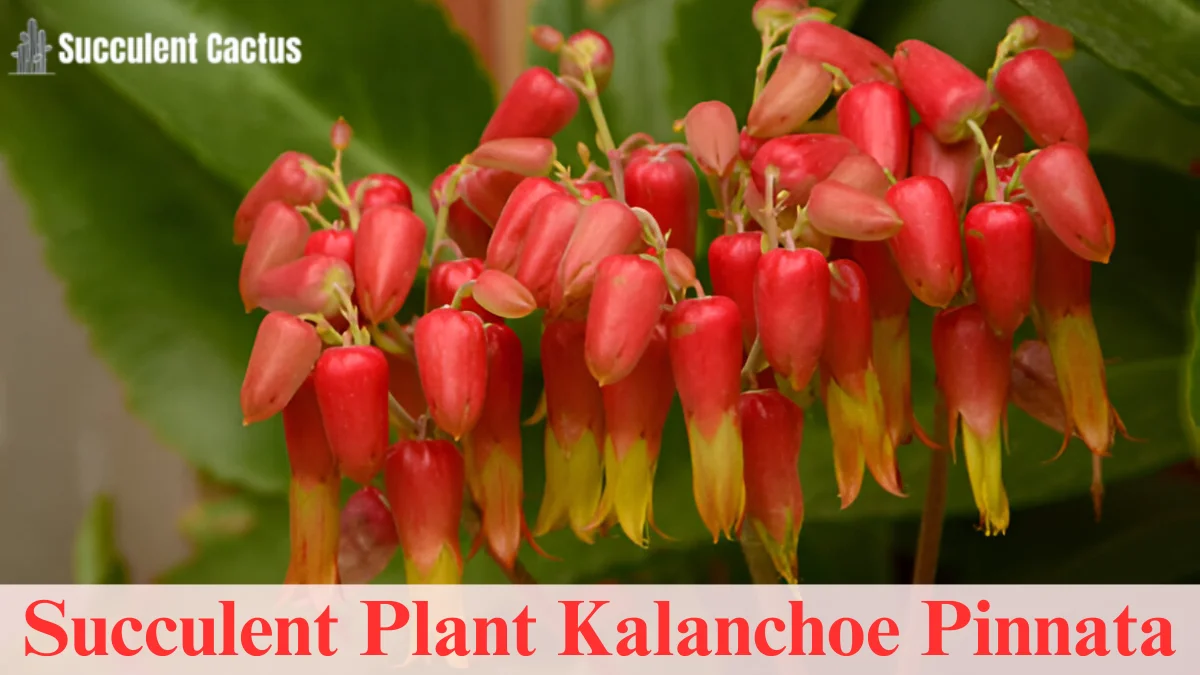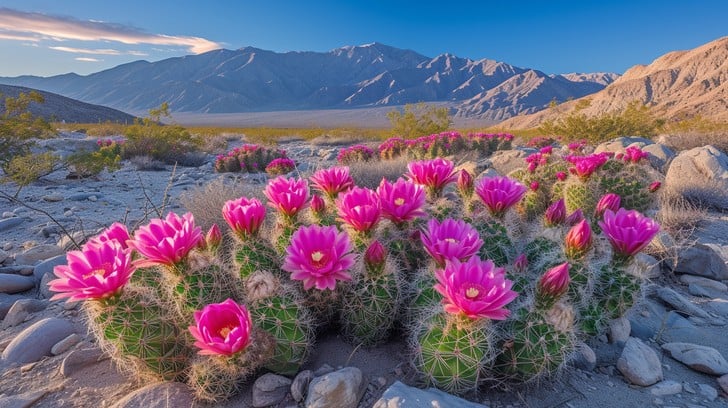Succulent Plant Kalanchoe and Kalanchoe Pinnata: A Complete Guide to Growing and Benefits

Succulent plants have gained a lot of popularity in the gardening world due to their attractive appearance and low-maintenance care. Among them, the Kalanchoe family stands out, with its eye-catching flowers, thick fleshy leaves, and exceptional resilience. In particular, Succulent Plant Kalanchoe Pinnata has gained much attention due to its unique appearance and medicinal properties. This blog provides an in-depth guide on both the Kalanchoe genus and the Kalanchoe Pinnata variety, discussing everything from care to propagation and medicinal uses.
1. Understanding Succulent Plant Kalanchoe
Kalanchoes are a popular type of succulent known for their colorful blooms and drought-tolerant nature. They have become an essential part of many gardens and indoor plant collections.
Origin and History
Kalanchoe plants belong to the Crassulaceae family and originate from Madagascar, Africa, and parts of Asia. The genus was first introduced to Europe in the 18th century, where they quickly gained popularity as ornamental plants due to their easy-care nature and stunning flowers. Today, they are grown all over the world, both indoors and outdoors, in regions with temperate climates.
Popular Varieties of Kalanchoe
Kalanchoe has over 200 species, and each variety has its unique characteristics. Some of the most popular varieties are:
- Kalanchoe Blossfeldiana: One of the most widely grown species, known for its small, vibrant, and long-lasting flowers in red, pink, yellow, and orange.
- Kalanchoe Luciae (Paddle Plant): Recognized for its large, paddle-shaped leaves that turn red at the edges when exposed to the sun.
- Kalanchoe Beharensis: Known as the “Felt Bush,” this variety features soft, velvety leaves with a silvery coating.
These varieties are often used in floral arrangements, pot plants, or even ground cover in warm climates.
Why Kalanchoe is a Favorite Among Succulents
Kalanchoes are favored for their easy care and vibrant blooms. They can tolerate dry conditions, making them perfect for beginners and those with less time for regular plant care. The thick, fleshy leaves of the Kalanchoe store water, which makes them extremely drought-tolerant. They also bloom beautifully throughout the year, ensuring that your space is always filled with colorful flowers.
2. Spotlight on Succulent Plant Kalanchoe Pinnata
Succulent Plant Kalanchoe Pinnata is one of the most fascinating varieties of Kalanchoe. Known as the “Miracle Leaf,” this species offers both ornamental beauty and medicinal value.
Origins and Cultural Significance
Succulent Plant Kalanchoe Pinnata is native to Madagascar, but it has spread throughout tropical and subtropical regions of the world. This plant has a rich cultural significance in many parts of the world. In places like Africa, India, and China, Kalanchoe Pinnata has been used for its healing properties for centuries. Its regenerative ability is believed to symbolize resilience and healing, which makes it a favorite in folk medicine.
Unique Characteristics of Succulent Plant Kalanchoe Pinnata
The Succulent Plant Kalanchoe Pinnata has large, fleshy green leaves with reddish-purple edges. These leaves are highly succulent and store a lot of water, enabling the plant to thrive in dry conditions. During the blooming season, Kalanchoe Pinnata produces small, bell-shaped flowers in hues of yellow, orange, or red. The plant is also known for producing small plantlets along the edges of its leaves, which can be propagated easily to grow new plants.
Table: Succulent Plant Kalanchoe Pinnata Characteristics
| Feature | Details |
| Leaf Type | Thick, succulent leaves with reddish-purple edges |
| Flower Color | Yellow, orange, or red bell-shaped flowers |
| Propagation Method | Plantlets along leaf edges, stem cuttings, or leaf cuttings |
| Watering Needs | Low to moderate watering, drought-tolerant |
| Medicinal Uses | Antiseptic, anti-inflammatory, respiratory health |
Medicinal Importance of Succulent Plant Kalanchoe Pinnata
Succulent Plant Kalanchoe Pinnata has been used for centuries in traditional medicine, primarily for its healing and anti-inflammatory properties. The plant’s leaves contain compounds believed to have antimicrobial and anti-inflammatory effects. It is often used to treat wounds, cuts, and burns, and has been shown to reduce swelling and pain when applied topically. Additionally, herbal tea made from Kalanchoe Pinnata leaves is said to have respiratory health benefits, helping to relieve coughs, colds, and bronchitis.
3. Choosing the Right Soil for Kalanchoes
The quality of the soil you use for your Kalanchoes is crucial to their health and growth. Kalanchoes thrive in well-draining soil, as they are highly susceptible to root rot if the soil retains too much moisture.
Importance of Well-Draining Soil
Succulent plants, including Kalanchoes, need soil that drains quickly to prevent waterlogging. Clayey or heavy soils can trap moisture and suffocate the roots, leading to root rot. Kalanchoes need soil that allows excess water to drain away while still providing enough moisture to keep the plant hydrated.
How to Improve Drainage
- Add Perlite or Sand: Mixing perlite, pumice, or sand with the soil helps improve drainage by increasing air pockets and reducing water retention.
- Use a Gravel Layer: Placing a layer of small stones or gravel at the bottom of your pot allows excess water to flow through without disturbing the soil.
DIY Soil Mix for Kalanchoes
Here’s an ideal soil mix you can make at home to ensure your Kalanchoe gets the best growing environment:
- 50% regular potting soil
- 25% sand or perlite
- 25% pumice or cactus mix
This combination ensures excellent aeration, keeps the roots from becoming waterlogged, and provides the plant with the nutrients it needs.
4. Light Requirements for Kalanchoes
Proper lighting is essential for the health and blooming of Kalanchoe plants. The amount of light a plant receives can directly impact its growth and flower production.
Best Lighting Conditions
Kalanchoes thrive in bright, indirect light. They need at least 6–8 hours of sunlight daily to promote healthy growth and flower production. While they can tolerate some direct sunlight, it’s best to avoid prolonged exposure during the hottest part of the day, as this can scorch the leaves.
Indoor vs. Outdoor Light
- Indoors: If growing indoors, place your Kalanchoe near a south or west-facing window to receive plenty of sunlight. East-facing windows provide softer morning light, which is also ideal for Kalanchoes.
- Outdoors: If growing outdoors, choose a location with partial shade. In regions with intense summer sun, a bit of shade can help prevent leaf scorch.
Signs of Poor Lighting
If your Kalanchoe is not receiving enough light, you might notice the following symptoms:
- Leggy growth: This occurs when the plant stretches toward the light source.
- Weak flowering: If the plant doesn’t receive enough sunlight, it may fail to bloom properly or produce fewer flowers.
On the other hand, too much direct sunlight can cause sunburn on the leaves, leading to brown or yellow spots.
5. Watering Kalanchoes
Watering Kalanchoes properly is vital to their success. These plants are drought-tolerant but still need periodic watering to thrive.
How Much Water Do Kalanchoes Need?
The general rule of thumb for watering succulents is to water when the top 2 inches of soil are dry. Overwatering is the most common mistake when growing Kalanchoes, as they can’t tolerate sitting in wet soil for extended periods.
Adjusting Watering for Seasons
Kalanchoes are dormant in the winter months, and their water needs decrease. Here’s how to adjust watering throughout the year:
- Summer: Water more frequently, around every 7–10 days, as the plant is actively growing.
- Winter: Reduce watering to once every 3–4 weeks.
Signs of Overwatering or Underwatering
- Yellowing leaves are often a sign of overwatering.
- Shriveled or dried-out leaves indicate the plant is underwatered.
If you notice the signs of either problem, adjust your watering schedule accordingly.
6. Fertilizing Kalanchoes
Fertilizing Kalanchoes ensures they receive all the nutrients they need for healthy growth and vibrant flowers.
Choosing the Best Fertilizer
Select a balanced liquid fertilizer with a nutrient ratio of 10-10-10. Alternatively, you can choose a fertilizer specifically designed for succulents and cacti. These fertilizers typically have a lower nitrogen content, which is better suited to the needs of Kalanchoes.
Fertilizing Frequency
Fertilize your Kalanchoe plant every 4–6 weeks during the growing season (spring and summer). During the fall and winter, when the plant is dormant, reduce fertilization to once every 2 months.
7. Pruning and Maintaining Kalanchoe Plants
Regular pruning is essential to maintain the health, shape, and blooming potential of your Kalanchoe plants. It also ensures that the plant remains free from diseases and pests.
Why Pruning Is Important
Pruning helps your Kalanchoe plant grow in a compact, bushy form rather than becoming leggy. It also promotes new growth, which can result in more flowers during the blooming season. Regularly cutting back dead or damaged leaves encourages the plant to focus its energy on healthy areas.
How to Prune Kalanchoe
- Remove Dead or Dying Leaves: Cut away any dead or diseased leaves at the base where they meet the stem. This will help prevent fungal infections and improve the overall appearance of the plant.
- Pinch Back Flower Stems: After the plant finishes flowering, you can cut the flower stalks back to encourage new growth and additional blooming.
- Shape the Plant: For aesthetic purposes, you can prune Kalanchoe to maintain a tidy and even shape. Trim any overly long branches to promote a fuller appearance.
Pruning Tools and Tips
Use a clean pair of sharp pruning shears or scissors to avoid damaging the plant. Always sterilize your tools before use to prevent the spread of disease. Prune during the early growing season (spring or early summer) for the best results.
8. Common Pests and Diseases Affecting Kalanchoe
Kalanchoes are generally resistant to pests and diseases, but they can still fall victim to a few issues, especially when grown in less-than-ideal conditions.
Pests to Watch Out For
- Mealybugs: These small, white insects hide in the leaf joints and suck sap from the plant, weakening it.
- Aphids: Tiny green or black bugs that can be found on new growth, leaving behind sticky honeydew and potentially spreading diseases.
- Spider Mites: Tiny red or yellow pests that cause speckled yellowing on leaves and may lead to leaf drop if not treated.
Common Diseases
- Root Rot: This is one of the most common diseases associated with overwatering. The roots of the plant become waterlogged, causing them to decay. Symptoms include yellowing leaves, wilting, and a foul smell coming from the soil.
- Powdery Mildew: A fungal disease that causes a white, powdery substance to form on the leaves. It thrives in humid conditions.
- Leaf Spot Disease: Caused by fungi or bacteria, it manifests as small, dark spots on the leaves. This disease is often worsened by overwatering or poor air circulation.
Preventing and Treating Pests and Diseases
- Neem Oil or Insecticidal Soap: These are great natural remedies to treat pests like mealybugs and aphids. Apply them regularly to keep the plant pest-free.
- Proper Watering Techniques: Avoid overwatering your Kalanchoe to prevent root rot. Make sure the soil dries out between watering sessions.
- Good Air Circulation: Ensure your plant is in a location with proper airflow, especially in humid environments, to prevent fungal infections.
9. Propagating Kalanchoe: Simple Steps for Success
Kalanchoe plants are easy to propagate, whether through stem cuttings, leaf cuttings, or plantlets that naturally form along the leaf edges. Here’s how you can successfully propagate your plant.
Methods of Propagation
- Stem Cuttings: Select a healthy stem with a few leaves attached. Cut it just below a node, remove the lower leaves, and let the cutting dry for a few days to form a callus. Then, place it in well-draining soil to root.
- Leaf Cuttings: Cut a healthy leaf from the plant and allow it to dry for a couple of days. Then, place the leaf on top of the soil, and it will eventually sprout small roots and new plantlets.
- Offsets/Plantlets: Kalanchoe Pinnata naturally produces small plantlets along the edges of its leaves. Simply cut off a healthy plantlet and place it in soil to root.
Propagation Tips
- Use Clean Tools: Always use sterilized scissors or shears to prevent the spread of diseases.
- Allow Cuttings to Callus: After cutting, let the plant material dry out for a few days before planting it in soil. This prevents rotting.
- Provide Warmth and Light: Place the cuttings in a warm, bright area but out of direct sunlight, which can burn the delicate new roots.
Success Rates and Timeframe
Most Kalanchoe cuttings root in 2–4 weeks under the right conditions. Once rooted, they can be treated like mature plants and repotted into larger containers.
10. Kalanchoe Pinnata as a Natural Remedy
Kalanchoe Pinnata is not only valued for its beauty but also for its wide range of medicinal uses, particularly in traditional medicine.
Key Health Benefits of Kalanchoe Pinnata
- Wound Healing: The plant’s leaves are used topically to treat cuts, burns, and bruises due to their antiseptic and anti-inflammatory properties.
- Respiratory Health: Kalanchoe Pinnata is also known for its ability to relieve symptoms of coughs, colds, and bronchitis when used as a tea or in tincture form.
- Anti-inflammatory Effects: Research has shown that the plant contains compounds that can reduce inflammation, making it useful for treating joint pain and other inflammatory conditions.
How to Use Kalanchoe Pinnata for Health
- Topical Application: Crush the fresh leaves and apply them directly to the affected area for wound healing.
- Tea or Tinctures: You can make tea by boiling Kalanchoe leaves in water. Drinking this tea is believed to help with respiratory issues.
- Poultice: A poultice made from the plant’s leaves can be applied to sore joints or inflammation.
Safety and Precautions
While Kalanchoe Pinnata offers numerous health benefits, it’s important to use it cautiously. Consult with a healthcare provider before using the plant medicinally, especially if you are pregnant, nursing, or have pre-existing health conditions.
11. Growing Kalanchoe Outdoors vs. Indoors
While Kalanchoe plants thrive in both indoor and outdoor environments, they each have specific needs and care requirements.
Growing Kalanchoe Outdoors
If you live in a warm climate, Kalanchoes can make excellent additions to your garden. Here’s how to grow them successfully outdoors:
- Sunlight: Plant your Kalanchoe in a spot that receives full sun for most of the day, ideally 6-8 hours of direct light.
- Soil: Ensure that the soil is well-draining to avoid root rot.
- Protection from Frost: Kalanchoes are not frost-tolerant, so if you live in an area with cold winters, consider bringing the plant indoors when the temperature drops below 40°F (4°C).
Growing Kalanchoe Indoors
Indoors, Kalanchoe makes a fantastic houseplant. Here’s what you need to ensure healthy growth:
- Lighting: Place your Kalanchoe near a south-facing window to ensure it gets ample light.
- Watering: Indoor Kalanchoes may require less frequent watering, as they are not exposed to the elements. Water only when the soil is dry to the touch.
- Temperature: Kalanchoes prefer moderate temperatures between 60°F (15°C) and 85°F (29°C).
Indoor vs. Outdoor Growth Considerations
- Outdoor Kalanchoes generally grow larger and may produce more flowers due to exposure to natural sunlight and temperature variations.
- Indoor Kalanchoes need to be protected from cold drafts and fluctuating temperatures but can thrive year-round in a controlled environment.
12. Troubleshooting Common Kalanchoe Problems
Though Kalanchoe plants are relatively easy to care for, they can still encounter a few problems that need attention.
Yellowing Leaves
Yellowing leaves are often a sign of overwatering or poor drainage. If the soil is too wet, it prevents the roots from getting enough oxygen, leading to root rot. Ensure the plant is in well-draining soil and only water when the top 2 inches of soil are dry.
Drooping or Wilting Leaves
This is usually a sign of underwatering. Check the soil moisture and water the plant thoroughly if it appears dry. Kalanchoes are drought-tolerant, but they still need regular watering, especially during hot months.
Lack of Flowers
If your Kalanchoe isn’t flowering, it may not be receiving enough light. Ensure it gets at least 6-8 hours of bright, indirect light each day. Additionally, fertilize regularly with a balanced fertilizer during the growing season to promote healthy blooms.
FAQs
Q1. How often should I water my Kalanchoe plant?
Ans: Water your Kalanchoe every 7–10 days during the growing season. In winter, reduce watering to every 3-4 weeks.
Q2. Can Kalanchoe Pinnata be grown indoors?
Ans: Yes, Kalanchoe Pinnata can thrive indoors with proper sunlight and care. Place it near a sunny window to receive adequate light.
Q3. What is the best soil for Kalanchoe Pinnata?
Ans: Use a well-draining succulent mix with added perlite or sand. It helps prevent root rot.
Q4. How do I propagate Kalanchoe Pinnata?
Ans: You can propagate Kalanchoe Pinnata by planting the plantlets that grow along the leaf edges in soil or using leaf cuttings.
Q5. Is Kalanchoe Pinnata safe for pets?
Ans: Kalanchoe Pinnata can be toxic to pets if ingested. Keep it out of reach of animals.
Conclusion
Succulent plants, particularly Kalanchoe and Kalanchoe Pinnata, are wonderful additions to any garden or indoor space. Their low-maintenance care, beautiful flowers, and medicinal benefits make them incredibly versatile and rewarding. By following the right care instructions for lighting, watering, and soil, you can ensure that your Kalanchoes thrive for years to come. Whether you’re interested in their ornamental beauty or their health benefits, the Kalanchoe species provides something for everyone.






